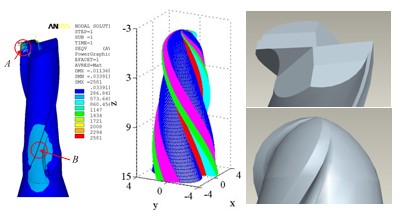AMT lab was founded in May 2010, which grew out of the cutting technology laboratory of Beijing Institute of Technology. Researches on the cutting of special difficult-to-cut materials has been the focus and characteristic of the lab since the 1950s and 1960s. Prof. Qixun Yu and other old professors have made important contributions to the invention and popularization of Ni Zhifu drill. At present, the lab is one of the main supporting units of Key Laboratory of Fundamental Science for Advanced Machining, the innovation platform member and innovation alliance governing unitof national "High Speed and High Efficiency Machining Equipment and Technology", as well as the lead unit of “Common Problems of Machining Database” program of National Natural Science Foundation of China (NSFC).
There are 14 formal faculty members including 4 professors (one 973 Chief Scientist and one Youth 973 Chief Scientist / youth thousand people), 4 associate professors, 1 lecturer, 5 experimenters, and more than 40 graduate students. The advanced machining equipment and testing equipment in the lab include five-axis NC machining center (DMG), ultra-precision machine tool (Nanoform), six-axis CNC grinding machine (CNS7d), high precision CNC glass molding machine (SYS), trilinear coordinates measuring instrument (Hexgon), 3Dlaser scanning microscope (Keyence), high temperature metallographic microscope (Zeiss), white light interferometer (Taylor Hobson), multi-component dynamometer (Kistler) and so on.
AMT lab has developed researches on machining of difficult-to-cut materials, meso-scale micromachining, process design and data service, advanced grinding and cutting tool manufacturing, micro/nano optical manufacturing, anti-fatigue manufacturing and so on. AMT lab and the Japan Society of Precision Engineering (JSPE) jointly sponsored and hosted the 4th International Symposium on Micro/Nano Mechanical Machining and Manufacturing (ISMNM) between 2010 and 2016. AMT lab has also developed good international cooperative relationships with Ohio State University (USA), the University of Toronto (Canada), Karlsruhe Institute of Technology (Germany), University of New South Wales (Australia), Tohoku University and Akita Prefectural University (Japan).
AMT lab has undertaken more than 50 projects of NSFC, 973 of National Defense, 973 of Youth Scientists, etc. with the scientific research fund of more than 60,000,000 yuan since the 11th Five-Year Plan. More than 300 papers have been published, of which more than 200 papers have been included in SCI/EI. The lab has obtained more than 30 national invention patents and more than 20 software copyrights. The research achievements obtained by AMT lab have been widely applied in the development and production of products.
Besides, AMT lab provides many courses for undergraduate and graduate students, such as Foundation of Precision Manufacturing Engineering, Machinery Manufacture Engineering, Finite Element Analysis of Mechanical Structures, Quality Engineering, Manufacturing and Machine Tools, Advanced Machining Theory, Similarity Engineering and so on.
1. Machining and simulation of difficult-to-cut materials
High-speed & high-precision machining of difficult-to-cut materials; Machining-process-oriented phenomenological material constitutive modeling methodology based on experiments and multi-scale simulations; Surface integrity and fatigue properties of the machined surface and subsurface; Progressive tool wear mechanisms and prediction based on differential-type wear rate models; MD & FEM-based nano/micro/meso/macro-scale machining simulation technology; Design theory and preparation technology of complex-structure, precision & compound tools; Shot peening and laser-shock strengthening technology, etc.

Fig.1 High efficiency cutting and simulation
2. Meso-scale micromachining
Studying on integrated structure-parameter-edge design of micromachining tool, failure analysis of micromachining tool, integration machining principle of the meso-scale parts and the tool path planning, interaction mechanism and dynamic evolution of the micromachining process, 3D stability analysis and chatter suppression of micromachining, precision measurement and characterization of the machined surface topography, etc.

Fig.2 Integrated structure-parameter-edge design of micromachining tool
3. Process precision control and data service
In view of the serious tool wear in machining of high strength and high hardness materials, the large deformation in machining thin-walled weak stiffness box parts, researches on acquisition and analysis technology of physical data of multi-source and heterogeneous machining, knowledge mining technology oriented to shape and performance of machined surface, simulation analysis and precision control of the machining deformation of the thin-walled complex structure were carried out. Machining data service platform based on machining physics basic data and process knowledge were established.

Fig.3 Process precision control and data service
4. Advanced grinding and cutting tool manufacturing
The main research interests are: 1) ultrasonic assisted grinding of optical crystals such as sapphire/silicon, optical micro structure grinding, grinding and SPH simulation of hard and brittle materials, precision grinding of high strength steel gears, precision grinding superhard alloys; 2) design and grinding of micro cutting tool, high frequency pulsed magnetic field positioning strengthening of micro cutting tool; 3) ultrasonic assisted micro drilling/milling, five-axis machining of micro complex surfaces; 4)rolling processing of high-strength steel, ultrasonic assisted rolling and its tool technique.

(a). Abrasive grain traces of conventional grinding

(b) Abrasive grain traces of ultrasonic assisted grinding

(c). Six-axes CNC tool grinding machine and ultra-small micro end mill
Fig.4 Grinding and testing of micromachining tools
5. Micro/nano optical manufacturing
Studying on the microstructure array mold for glass molding machined by high precision diamond cutting tool, preparation of nickel-phosphorus (Ni-P)plating for the new mold material, tests and analysis of the characteristics, composition control and performance strengthening technology of Ni-P material, finite element cutting simulation model of Ni-P, shear slip mechanism of the multiphase Ni-P in micromachining process, etc.. The research of optical lens, Finel lens and microstructural array was carried out to achieve the goal of high precision, high efficiency and low cost preparation of complex structure micro-optical devices. The high temperature constitutive modeling of viscoelastic materials, interfacial friction and lubrication, bonding and separation of forming parts were also studied to achieve the size minimization and area maximization of microstructures with high precision and high efficiency.

Fig.5 Microstructure array mold and infrared microlens & optical glass micropyramid array produced by glass molding